Travelers are getting bored, they don’t pay attention to what you say, they lose focus… This happens because you’re too focused on “explaining” and not on “capturing travelers’ attention”. And one way to wake up your travelers is to create an experience in which they can be involved.
After many hours searching for and interviewing our best gurus, we finally brought out this post with the best tips to create an interactive tour, let’s go!
- 1. Break the ice from the beginning
- 2. Bond with travelers throughout the tour
- 3. Ask questions
- 4. Let travelers ask their questions
- 5. Include the group into your stories
- 6. Teach something
- 7. Take a fun group picture
- BONUS: Asking questions to travelers
- DOUBLE-BONUS: Remember the names of your travelers to get more money!
1. Break the ice from the beginning
Travelers may feel intimidated or a little shy to speak in front of a group of strangers they just met. So you have to break the ice as soon as possible.
It starts when they reach the meeting point. Welcome them, share some things you know about their country, show your interest by asking them what you can visit if you travel there or learn to say “thank you” or “welcome!” in their language. Make sure they feel comfortable
When the tour starts, invite travelers to introduce themselves to the group, saying, for instance, their name and something else, which could be their nationality (ideally you introduce yourself this way before, so they have an example to follow). If you do a food tour, you could ask about their favorite food, if you do a tour based on Harry Potter, you could ask their favorite character or the one they can’t stand. This helps a lot to take away the fear of speaking in front of the group and invite travelers to bond with each other thanks to what they have in common.
Another option could be to ask who traveled the most to come here, or you can give them 2 options and travelers should split the group choosing one of these options. For example, you could split between salty and sweet people in the case of a food tour. This also helps you identify the kind of travelers you have on the tour to better focus your speech.
The first few minutes of your speech are also crucial to break the ice. Using humor is the best solution. In another post we will explain to you how to build the best introductory speech.
2. Bond with travelers throughout the tour
Take advantage of the whole tour to bond with travelers, especially when you are walking from one stop to another. It creates a feeling of trust for travelers to get more involved during the tour. It is especially important with:
- People who travel alone: the risk they’re getting bored is higher as they don’t have anyone to talk with during the tour.
- People who are not native speakers of the language you are giving the tour in:They may feel uncomfortable to speak in front of native people, so to get them more involved, try to empower them when talking with them, saying how great they’re doing speaking English, for instance.
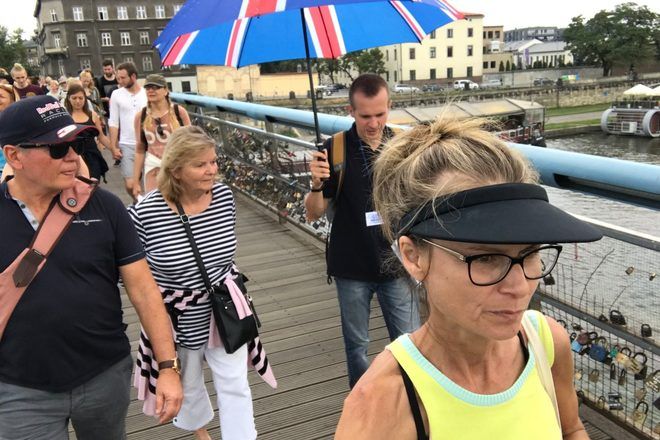
3. Ask questions
It’s the easiest way to get travelers involved. Moreover, when travelers answer well, they feel very happy and cheerful travelers have a better time and give more money!
If someone gives an answer, although it’s not correct one, it’s important they feel recognized. You can always say “thank you” and if he or she finds the right answer, you can even give him / her a high five.
There are many different types of questions you can ask travelers, such as asking them if they can identify something during a stop (search for something), based on the travelers’ own experience (does anyone know …?) Or about something you said during the tour (Does anyone remember …?). You can even do a quiz or use questions to animate the group.
At the end of the article, you will find a bonus with more information and a video on asking questions!
4. Let travelers ask their questions
“Does anyone have questions?” We advise asking it at the end of each stop. It’s important to give your ravelers the opportunity to ask their questions. Otherwise, they may feel frustrated.
You can encourage it using humor: “If I find out that someone didn’t understand what I just said, he or she will have to come again for the tour tomorrow.” There is also a guide who hands out small papers to his travelers with questions written on them and so when he finishes explaining, he makes sure there are questions. That allows travelers to be assured they’ll have a great question to ask.
You should also be available to answer questions when you walk between 2 stops in case a traveler wants to ask you one . If you notice that travelers always ask you the same questions, try to include the answer in your speech, so they don’t have to ask you anymore.
If a traveler asks you a question that needs a very long answer and if it’s maybe not interesting for the whole group, answer it after the tour. But don’t do it between 2 stops because otherwise the group will have the impression of losing some explanations.
5. Include the group into your stories
When you include the group in your explanation, travelers will pay much more attention since you are connecting the history and the tour with them directly. For example in Porto, a guide divides the group into 2 small groups during a stop: one group was Brazil and the other one was Portugal. Then she explained the historical movements between these 2 countries moving travelers from one group to another.
You can also ask for the participation of a volunteer to hold a map, or your umbrella for example. But you can also use it to illustrate your explanations. If no one offers himself or herself as a volunteer, you will have to “choose a volunteer”, which creates a very funny situation.
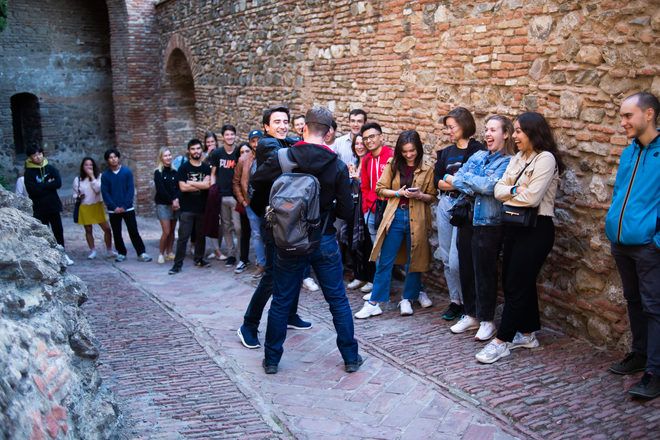
Also use contrasts. If you are looking for someone to make a mean Viking warrior, use a little kid or an elderly lady. That will make people laugh as people did not imagine a Viking warrior like that. But of course, be careful not to fall into stereotypes that can be misinterpreted.
Let everyone have their part. In the case of volunteers, try not to use the same person twice. People identify a lot with the role they played during the tour, and sometimes they even write it in the reviews of your tour.
So here’s are some examples:
- Re-enact a historical scene. For instance in Valencia, a guru illustrates the process of the Spanish inquisition by making a mini-play. He goes back in time and becomes a judge. He takes a volunteer, who will be guilty of a thousand things during the inquisition, and the group thinks they are in a courthouse, attending a trial. Travelers like it a lot because they are living History and they will remember it better too. Also, it creates a funny situation because of the poor volunteer who didn’t ask for it but ends up being the center of attention. Another example, in Athens, could be explaining with a volunteer what the Olympic Games were like in the old days.
- Imitate what the guide says. For example, you could tell a love story and take 2 volunteers to imitate what you explain to the group, which is very funny. You could also explain the whole process of a recipe that a volunteer would try to reproduce by imitating what you say, or it could even be imitating the life cycle of a very iconic animal from your city along with many other things.
Try to also play with kids since they tend to quickly lose attention during the tour. If they have a good time, their parents will be very happy too and this will be positively reflected in your payment and the review they will write you. 😉
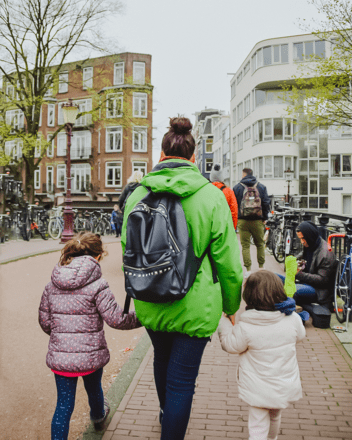
6. Teach something
The goal is to teach travelers something to feel like locals. We recommend introducing it with a story or legend. Although you are not explaining any famous monuments, travelers like it because they also want to know about the lifestyle and traditions of your city.
So for example:
- Teach a dance. For example, you could teach the basics of flamenco in Spain, or salsa in Colombia, … Teach it in a fun way. For instance, in Madrid, they explain flamenco as “take an apple in your hand, smell it and throw it on the ground and crush it with your foot.”
- Teach a custom from your country. For example, if you live in Turkey, you could teach how to negotiate when you buy something and you could try doing it with travelers. Or another example in Milan, you could teach how to use your hands as it’s very typical to speak with your hands in Italy.
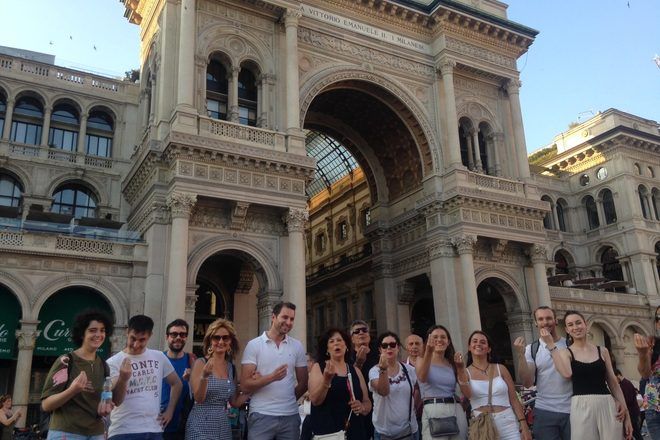
- Teach typical words. It’s something very popular on free walking tours. For example in Amsterdam, the guru teaches 2 words related to the topic of the tour, which is food (so the words are lekker and gezellig), which he repeats throughout the tour, and also asks travelers to repeat them. So it makes it very funny and useful for travelers. They are usually words that don’t have an exact translation in other languages. Another example is the famous Danish “hygge”.
- Teach a typical game from your city. Ideally, all travelers can play it and it doesn’t take long. For instance in Mexico, you could play a simplified version of the national lottery.
- Teach a typical song. We have for instance a guide who gives a piece of paper with the lyrics of a famous song for travelers to sing along with between 2 stops. It’s also possible that what you explain during a stop is related to a song, like in Dublin when the guide shows the statue of Molly Malone. No need to sing the whole song of Molly Malone, but you could sing the main part for instance. Of course, it’s easier if travelers already know the song.
If you see that this kind of activity may not please everybody, you could always use it when you decide to make a short break in the middle of the tour. While some travelers go for a coffee or water, the ones that remain could spend the time doing your activity.
7. Take a fun group picture
The majority of gurus take a group picture in one of the most beautiful places in their city. Instead of taking a normal group photo, think how it could be a fun memory for travelers.
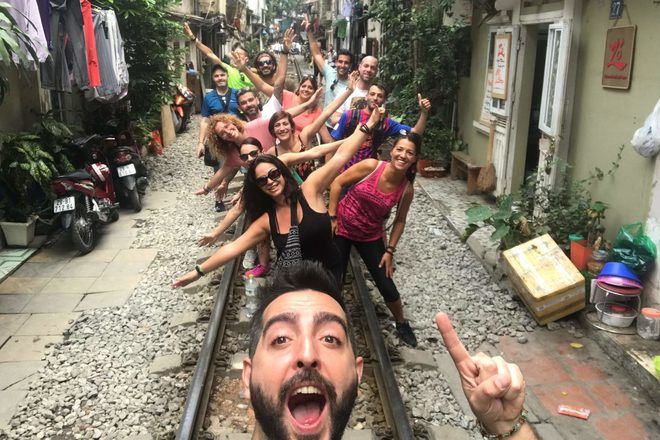
The group could take the picture as if they were representing a painting, a tradition, a sport, a meal, an event, a statue, etc. For example, in Paris, it could be taking a picture with everybody imitating the Da Vinci’s Mona Lisa. Or in Athens, travelers may pose as if they were athletes in front of the Olympic stadium… Also think about what could be said when the picture is taken: so maybe the name of your city, a special word… You can find more ideas in this post about the best pictures.
You don’t always have to take a group picture. It depends on the chemistry you have with the group. There is nothing worse than taking a picture when people don’t want it. If you took a good picture, you can send it to the travelers and also remind them to leave a very good review.
BONUS: Asking questions to travelers
Asking questions to travelers is one of the easiest way to get them involved during your tour. Moreover, travelers feel so happy when they find the right answer and it’s exactly what you are looking for! Don’t forget to say thank you to travelers for participating or even giving them a high five (only in the case there is no need for social distance anymore).
Types of questions you can ask travelers:
- Riddles. For example: “Look at this building, can anyone tell me what it’s used for?
- Based on the travelers’ own experience. It can be used as an introduction to the topic you are going to develop. For example: “Does anyone know who is the current Belgian King?” or “Why, do you think, people decided to start a city here?”
- Quiz. For example in Valencia, we have a guru doing a quiz asking all the ingredients of the traditional paella. In Brussels, when I was a guide, I used to do a quiz with printed pictures of the most famous Belgian people, to see if travelers know who they were. Also, if you have a small speaker, you can even do a quiz of the most famous songs from your city or country, to see if travelers recognize them. These quizzes are interesting at the last stops of the tour, when travelers are already a little tired.
- Searching for something. These are small games. “This column is 1000 years old, but there is a part which is only 100 years old, can you spot it?” or “Look at this facade, there is a goose hidden somewhere, does anyone see it?”
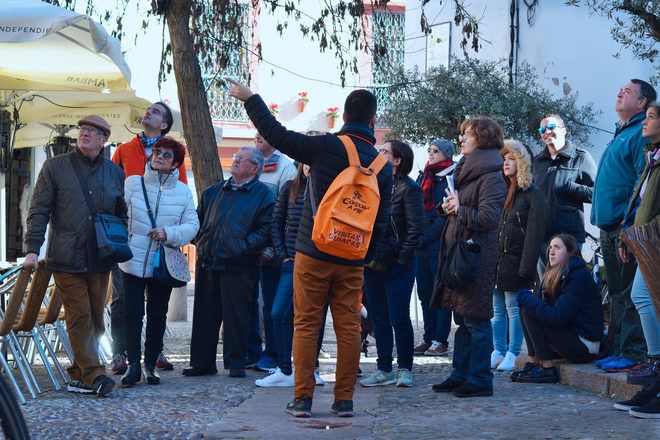
- Based on what you said. This is very useful to see if travelers have paid attention. For example: “Here we are at Jaime I Square, does anyone remember who he is?” Although you don’t provide new information, it allows you to connect with what you explained and it shows travelers that they learned something useful they can already use.
- Comparing with travelers. For example, if you talk about a tradition, you can ask if there’s a similar tradition in the countries of the travelers, like “Who also celebrates that in their country? Please raise your hand.” You can also ask some travelers to tell you how it’s celebrated in their country, but make that this does not last too long so you don’t lose focus. Moreover, we recommend it when other travelers show they are interested (you can see it if they ask something too).
- To animate the group. At the beginning of the tour, you can say with lots of enthusiasm “Hellooo!! Welcome to my tour! How are you doooooing?!” Raising your arms. Or “Are you ready to have fun?!” It works well with large groups. A guide in Valencia also asks how the group is doing at the end of each stop. Throughout the tour, people say “Goooood” but when they say it before the last stop, the guide says: “Nooooo! You should be sad, the tour is almost over” with an ironic upset tone. It gives his travelers a good laugh.
It’s important that your questions are easy to answer. In case it’s a more difficult question, you can always give some clues until they find it. Also use phrases like “Does anyone know …?” or “Maybe someone knows about …?” This way, it doesn’t look so bad if nobody knows how to answer.
If you see that people don’t feel comfortable to answer, you can encourage them, for example:
- Giving a little gift. You know, people love to win something. You can give a candy when someone answers well (and this works for everybody, even old people!), but it can be other things like a bracelet or another type of cheap souvenir. We even have a guru who offers seeds of a famous tree of his city related to a legend. And of course that doesn’t cost you anything.
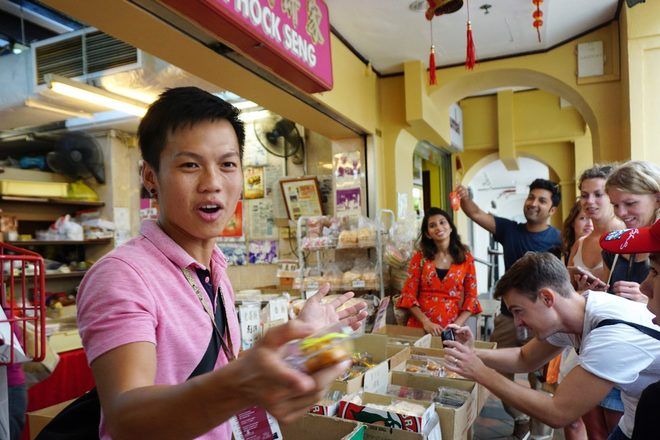
- Using humor. For instance, in Florence, a guide says: “If you don’t know how to answer that question, I’m leaving.” In Valencia, a guide uses the concept of the Eurovision Song Contest to encourage travelers to answer. When a traveler answers well, he says like in the contest “12 points FOR” and then the country where the person comes from, etc. and then says at the end of the tour which country won the most points.
- Warning travelers. For example, using humor: “Now we are going to see the island of love, and be careful that I will ask someone why it’s called that!
DOUBLE-BONUS: Remember the names of your travelers to get more money!
Did you know that our name is the most important for each of us? Do you imagine the positive effect to your walkers if you get to remember their names?
When you listen to your name, an incredible effect is produced on yourself. Your senses are suddenly sharpened towards the person that told your name. Your pupils are dilated and you start to pay attention to this person. It happens this way because we feel considered when we listen to our name.
The author of the book “how do you to earn friends and influence people”, Dale Carnegie, wrote the following:
“A person’s name is to him or her the sweetest and most important sound in any language.”
Anyway, it’s really difficult to remember the names of all your walkers. That’s especially the case when we have a huge group. So, we decided to write this post to bring you the best tips to remember the names of your walkers 🙂
Let’s go!
1. If you don’t keep attention, it’s not going to work!
A major reason you don’t recall names is you weren’t listening. Someone says their name and two seconds later you don’t know it. This is not a memory problem. It is a focus problem”
2. Remember the names by repetition
Imagine that I’ve booked your guruwalk and when you meet me, I tell you: “Hi, my name is Pablo!”. This moment will be the first opportunity to do the first repetition: “Hi Pablo, I’m am…!”. This first repetition will help our brain to remember better the names.
If you repeat aloud the traveler’s name a lot of times, during the conversation, you are going to remember the names easily.
For example, if you get to remember my name and 30 minutes later you told me: “Hey Pablo! do you have any questions?”, I will think… “Wow! The guru really knows my name!”. My attitude will be more positive and I will give you more money at the end of the tour 🙂
3. Focus your attention on one physical characteristic of your walker
4. Remember the names thanks to famous people
5. Connect the new name with an image
Hope you enjoyed this post! Tell us what you think of these tips and don’t hesitate to reach us if you have other ways to remember the names of your walkers.